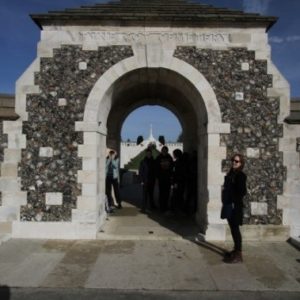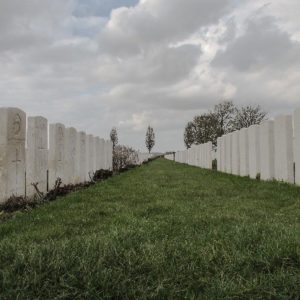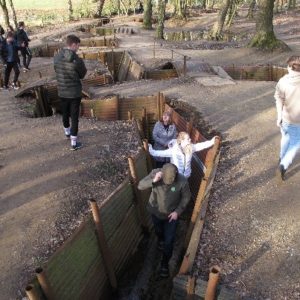Historians Moved by Belgian Battlefields
Some of our Year 9 and Year 10 history students went on a historic trip to the Battlefields of Belgium last week. Here is an account of the trip, written by history teacher Ms Kenward.
“On Friday 16th March, at a horribly early time for teenagers, the History department took 20 Year 9 and 20 Year 10 historians to Belgium. We travelled via Dover to get the essential coffees and iced drinks for a freezing cold morning, then hopped on the train to Belgium.
We arrived in the beautifully rebuilt town of Ypres, which was destroyed in WW1, but was rebuilt to the exact same standards after the war. Our students visited the Menin Gate which has the names of 56,000 soldiers who have no known grave, which was a very harrowing site. We then visited the museum, followed by a waffle and chocolate shop where many students bought sweets and gifts for their families.
We then travelled to the Essex Farm Cemetery where the famous poem ‘In Flanders Field’ was written and our historians got their first glimpse of the quiet dignity of the British Commonwealth graves.
We ventured on to Langemarck – a German grave site -which many students found hugely contrasting, yet highly moving. Mr Pringle had kindly provided students with a poppy each to place on a grave in Tyne Cot, which is the largest cemetery in the Ypres Salient and some students even managed to locate graves of ancestors in the cemetery, which was a very emotional and powerful experience.
Finally we travelled to Hill 62 where students got to wade through mud, clamber through dark tunnels and splash through the muddy craters to get an experience of trench life. The day was a long but rewarding one and I’d like to thank all our students for their exemplary behaviour on the day. Thank you also to the parents and carers who had to be up both very early and very late and also to Mr Pringle, Mr Wilson, Mrs Hazel, Mr Whitney and Mr Mayes for their support and huge help on the trip.”
Students Imogen, Saoirse and Dania shared their thoughts on the day, “We’d learnt about World War 1 in history lessons, but this trip brought it to life; we realised that the soldiers were real people, with families and loved ones left behind
“The British cemetery was nicer than the German one. The graves of the British soldiers had a headstone each, whereas the German graves seemed to be shared with lots of names on each. But the area itself, the countryside, is a bit bleak.
“We saw the Menin Gate, with over 50,000 names of soldiers who were never found, but writer Rudyard Kipling had written the inscription “Known Unto God”, which seemed very fitting. We also visited the trenches, where we went into tunnels and treatment bunkers – it was interesting for us, but must have been terrible for the soldiers.”
“It was a very very good trip and we would definitely recommend it to anyone who’s given the chance to go.”




